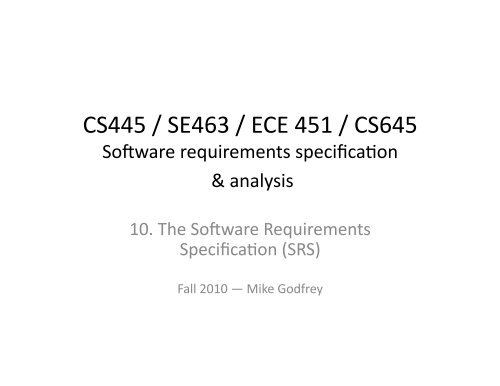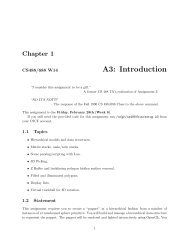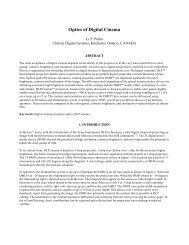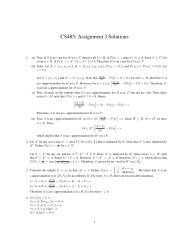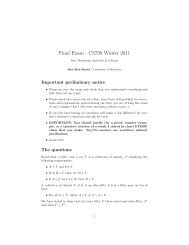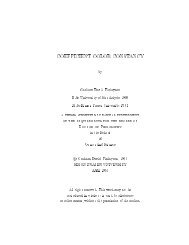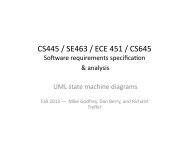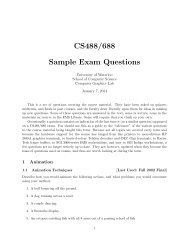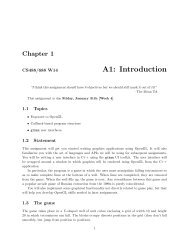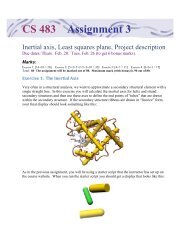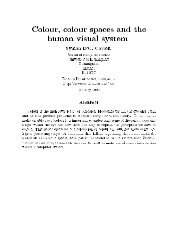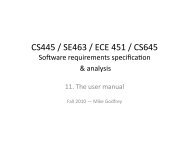CS445 / SE463 / ECE 451 / CS645 - Student.cs.uwaterloo.ca
CS445 / SE463 / ECE 451 / CS645 - Student.cs.uwaterloo.ca
CS445 / SE463 / ECE 451 / CS645 - Student.cs.uwaterloo.ca
You also want an ePaper? Increase the reach of your titles
YUMPU automatically turns print PDFs into web optimized ePapers that Google loves.
<strong>CS445</strong> / <strong>SE463</strong> / <strong>ECE</strong> <strong>451</strong> / <strong>CS645</strong> <br />
So,ware requirements specifi<strong>ca</strong>;on <br />
& analysis <br />
10. The So,ware Requirements <br />
Specifi<strong>ca</strong>;on (SRS) <br />
Fall 2010 — Mike Godfrey
Review: The requirements <br />
engineering process
RS vs. SRS <br />
• In prac;ce, there is no clear dis;nc;on between the terms <br />
• Virtually all commercial sw systems have some sort of <br />
requirements statement <br />
– Could be formal or very informal (e.g., user stories on s;cky notes) <br />
– I will <strong>ca</strong>ll this the Requirements Specifi<strong>ca</strong>;on (RS) <br />
• An SRS is an RS with a clear and defined structure, probably <br />
based at least loosely on the IEEE SRS format <br />
– So,ware created for external clients o,en uses SRS as contract <br />
– So let’s see what a formal SRS looks like
Overview <br />
• So,ware requirements specifi<strong>ca</strong>;ons (SRS) <br />
– IEEE standard for organizing an SRS <br />
• More reading: <br />
– IEEE Recommended Prac;ce for SRSs, 1998 (available from an <br />
on-‐<strong>ca</strong>mpus machine via the course web page) <br />
Lecture includes some excerpts from <br />
“Requirements document for an automated teller machine <br />
network” <br />
– h_p:/www.<strong>cs</strong>.umd.edu/projects/So,Eng/ ESEG/manual/<br />
error_abstrac;on/do<strong>cs</strong>/atm.ps <br />
[link checked Oct 2009]
SRSs <br />
• The IEEE Recommended Prac;ce for So,ware <br />
Requirements Specifi<strong>ca</strong>;ons (RPSRS): <br />
– Describes what informa;on should go in an SRS <br />
– How the informa;on should be arranged <br />
– Provides several sample outlines for an SRS
SRS contents <br />
• The main issues that the SRS should address are: <br />
– Func;onality <br />
• What the so,ware is supposed to do <br />
– External interfaces <br />
• How the so,ware interacts with people, the system’s <br />
hardware, other hardware, other so,ware <br />
– Performance <br />
• Required speed, availability, response ;me, recovery ;me of <br />
various so,ware func;ons
SRS contents <br />
– Quality a_ributes (NFRs) <br />
• What are the portability, correctness, maintainability, <br />
security, etc. considera;ons <br />
– Design constraints <br />
• Design decisions that constrain the set of acceptable <br />
solu;ons: standards, implementa;on language, policies <br />
for data integrity, resource limits, opera;ng <br />
environment(s)
SRS contents <br />
• Typi<strong>ca</strong>lly, the SRS does not address: <br />
– Process requirements <br />
– Design decisions
IEEE SRS organiza;on <br />
Table of Contents <br />
Table of Figures <br />
1. Introduc?on <br />
1.1 Purpose <br />
1.2 Scope <br />
1.3 Defini?ons, acronyms, <br />
abbrevia?ons <br />
1.4 References <br />
1.5 Overview <br />
2. Overall descrip?on <br />
2.1 Product perspec?ve <br />
2.2 Product func?ons <br />
2.3 User characteris?<strong>cs</strong> <br />
2.4 Constraints <br />
2.5 Assump?ons and <br />
dependencies <br />
3. Specific requirements <br />
/* variable organiza?on */ <br />
Appendices <br />
Index
Sec;on 1. Introduc;on <br />
• More of an introduc;on to the document than <br />
the actual system to be built <br />
1.1 Purpose <br />
– Purpose of the SRS <br />
– Who is the intended audience of this document? <br />
– How it is to be used? <br />
e.g., contract between vendor and customer? <br />
– .25-‐.5 pages
ATM example: Purpose <br />
This document describes the soSware requirements and <br />
specifi<strong>ca</strong>?on for an automated teller machine (ATM) <br />
network. The document is intended for the customer <br />
and the developer (designers, testers, maintainers). <br />
The reader is assumed to have basic knowledge of <br />
banking accounts and account services. Knowledge <br />
and understanding of UML diagrams is also required.
Sec;on 1. Introduc;on <br />
1.2 Scope <br />
– Name of the so,ware product <br />
– Overview of the product – what it will / will not do <br />
– Summary of the appli<strong>ca</strong>;on of the so,ware, <br />
including benefits, goals <br />
– The boundaries of the product <br />
– .25-‐.5 pages
ATM example: Scope <br />
The soSware supports a computerized banking network <strong>ca</strong>lled <br />
YouBank. The network enables customers to complete <br />
simple bank account services via automated teller machines <br />
(ATMs) that may be lo<strong>ca</strong>ted off premise and that need not <br />
be owned and operated by the customer’s bank. The ATM <br />
iden?fies a customer by a <strong>ca</strong>sh <strong>ca</strong>rd and password. It <br />
collects informa?on about a simple account transac?on <br />
(e.g., deposit, withdrawal, transfer, bill payment), <br />
communi<strong>ca</strong>tes the transac?on informa?on to the <br />
customer’s bank, and dispenses <strong>ca</strong>sh to the customer. The <br />
banks provide their own soSware for their own computers. <br />
The YouBank soSware requires appropriate record keeping <br />
and security provisions. The soSware must handle <br />
concurrent accesses to the same account correctly.
Sec;on 1. Introduc;on <br />
1.3 Acronyms, Abbrevia?ons, Defini?ons, Nota?onal <br />
Conven?ons <br />
– Usually for domain-‐level defini;ons used in the SRS <br />
– Project-‐related defini;ons should be in the Glossary. <br />
– Could just throw all defs into the Glossary <br />
– Explain any naming conven;ons you develop to help you write <br />
the document <br />
– Explain any nota;onal conven;ons for any devia;ons from <br />
standard UML nota;on <br />
– For example, you <strong>ca</strong>n be crea;ve with fonts or colour to denote <br />
different types of names, e.g., red for a_ributes, blue for opera;ons. <br />
– Colored informa;on stands out in a state diagram in which transi;ons <br />
are labeled with events, condi;ons, ac;vi;es, etc.
ATM: Defini;on vs. Abbrevia;on <br />
• Defini;on: <br />
– Account – A single account at a bank against which <br />
transac?ons <strong>ca</strong>n be applied. Accounts may be of <br />
various types with at least checking and savings. A <br />
customer <strong>ca</strong>n hold more than one account. <br />
• Abbrevia;on: <br />
– maxDailyWD – The maximum amount of <strong>ca</strong>sh that a <br />
customer <strong>ca</strong>n withdraw from an account in a day <br />
(from 00:00 AM to 23:59 PM) via ATMs.
ATM example <br />
• Defini;ons: <br />
– ATM <br />
– Bank <br />
– Bank computer <br />
– Cash Card <br />
– Customer Transac;on <br />
• Abbrevia;ons (constants) <br />
– maximum withdrawal per <br />
day and account <br />
– maximum withdrawal per <br />
transac;on <br />
– minimum withdrawal per <br />
transac;on <br />
– minimum <strong>ca</strong>sh in the ATM <br />
to permit a transac;on <br />
– total funds in the ATM at <br />
the start of a day
Sec;on 1. Introduc;on <br />
1.4 References <br />
– Your sources of informa;on, such as <br />
• Pre-‐exis;ng project documenta;on <br />
• Documenta;on of stakeholder interviews <br />
e.g., mee;ng minutes, videos, email <br />
• External info sources <br />
e.g., a textbook on telephony, web pages
Sec;on 1. Introduc;on <br />
1.5 Overview <br />
– Brief descrip;on of the structure of the rest of the <br />
SRS, especially: <br />
• Chosen organiza;on for sec;on 3 (more later) <br />
• Any devia;ons from the standard SRS format
ATM: Overview <br />
The rest of this document is organized as follows. Sec?on <br />
2 contains a general descrip?on of the ATM network <br />
soSware requirements. Sec?on 3 iden?fies the specific <br />
requirements, including external interfaces, use <strong>ca</strong>ses, <br />
func?onal requirements, and behavioral requirements. <br />
The document concludes with an appendix of glossary <br />
terms. <br />
Appendices consist also of minutes of customer interviews <br />
and mee?ngs, and do not cons?tute addi?onal <br />
requirements of the soSware; all requirements arising <br />
from these minutes have been incorporated into the <br />
specific requirements in Sec?on 3.
Sec;on 2: Overall descrip;on <br />
• This sec;on gives an overall descrip;on of the system under <br />
development, including general factors that affect the product <br />
and its requirements. <br />
– Do not state specific requirements here; instead, provide a background <br />
for those requirements, which are defined in detail in Sec;on 3, and <br />
makes them easier to understand. <br />
2.1 Product Perspec?ve <br />
2.2 Product Func?ons <br />
2.3 User Characteris?<strong>cs</strong> <br />
2.4 General Constraints <br />
2.5 Assump?ons and Dependencies
Sec;on 2: Overall descrip;on <br />
2.1 Product Perspec?ve <br />
– Describe the environment of the system <br />
e.g., hardware/so,ware components that interact with the system <br />
– Include a context diagram!
2.1 Product perspec;ve
2.1 Product perspec;ve <br />
• A detailed descrip;on is not necessary, since interface <br />
specifi<strong>ca</strong>;ons appear later in the document. <br />
– Give just an overview of the interfaces to other components in the <br />
environment. <br />
• This sec;on includes requirements of the user interface, such <br />
a testable usability requirements. <br />
– This is dis;nct from the user interface “design” that is described in <br />
Sec;on 3.
ATM: Product perspec;ve <br />
The ATM network does not work independently. It works <br />
together with the banks’ computers and the soSware run <br />
by the network’s banks. <br />
Communi<strong>ca</strong>?on interface – The ATMs communi<strong>ca</strong>te with the <br />
banking systems via a communi<strong>ca</strong>?on network; the <br />
protocol used is specified in [Ref1]. <br />
SoSware interface – The messages sent via the <br />
communi<strong>ca</strong>?on network are specific to the target banking <br />
soSware systems. At present, two known banking systems <br />
will par?cipate in the ATM network. The interfaces to these <br />
systems are specified in [Ref2], and [Ref3]. <br />
Hardware interface – The soSware will run on an ATM <br />
computer yet to be chosen.
ATM: Product perspec;ve <br />
• User interfaces <br />
– Customer – The customer user interface should be intui?ve, <br />
such that 99.9% of all new ATM users are able to complete <br />
their banking transac?ons without any assistance. <br />
– Bank Security Personnel – Bank security personnel are <br />
responsible for removing deposits and adding <strong>ca</strong>sh to <br />
ATMs. There should be a simple interface (e.g., a switch or <br />
buion) that they <strong>ca</strong>n use to ini?alize the ATM whenever <br />
they restock. <br />
– Maintainer – The maintainer is responsible for adding new <br />
ATMs to the network and servicing exis?ng ATMs. A <br />
maintainer should be possible to add a new ATM to the <br />
network within 1 hour.
Sec;on 2: Overall descrip;on <br />
2.2 Product Features <br />
– An overview of the system’s main features <br />
• Need give only a textual list of UC names (or “brief” UC <br />
summaries) <br />
• List should be complete <br />
• Features will be specified in detail in Sec;on 3
Sec;on 2: Overall descrip;on <br />
2.3 User Characteris?<strong>cs</strong> <br />
– Document any assump;ons you make about the user and <br />
any assump;ons you make about the background or how <br />
much training the user will need to use the system. <br />
• For example, you could build different user interfaces for <br />
knowledgeable and novice users. <br />
– Consider only user characteris;<strong>cs</strong> that affect the so,ware <br />
requirements
ATM: User characteris;<strong>cs</strong> <br />
• There are several users of the ATM network: <br />
– Customers are simply members of the general public with <br />
no special training. <br />
– Bank security personnel need have no special edu<strong>ca</strong>?on or <br />
experience. <br />
– Maintainers must be experienced network administrators, <br />
to be able to connect new ATMs to the network.
Sec;on 2: Overall descrip;on <br />
2.4 General Constraints <br />
– Sources of other constraints on requirements <br />
• regulatory policies <br />
• hardware limita;ons <br />
• parallel opera;on <br />
• audit func;ons <br />
• control func;ons <br />
• cri;<strong>ca</strong>lity of the appli<strong>ca</strong>;on <br />
• safety and security considera;ons <br />
• standards <br />
• laws
Sec;on 2: Overall descrip;on <br />
• Sec;ons 2.1 through 2.3 describe sources of possible <br />
constraints on requirements: <br />
– 2.1 describes exis;ng environment components that might <br />
constrain requirements <br />
– 2.2 describes desired func;onality <br />
– 2.3 describes users’ backgrounds that might affect usability <br />
issues. <br />
– You need to consider whether there are any sources of <br />
constraints on requirements or design. <br />
• Note that 2.4 isn’t NFRs per se <br />
– … but it is a set of sources of possible NFRs
Sec;on 2: Overall descrip;on <br />
2.5 Assump?ons and Dependencies <br />
– Assump;ons about input/environmental behavior, such as <br />
• hardware never fails <br />
• ATM <strong>ca</strong>sing is impenetrable <br />
• limited number of transac;ons per day (sufficient paper for <br />
receipts) <br />
• limited amount of money withdrawn per day (sufficient money) <br />
• people will naturally avoid railway crossing when gate is down <br />
– What condi;ons could <strong>ca</strong>use the system to fail? <br />
– What changes in the environment, could <strong>ca</strong>use changes to <br />
the so,ware requirements?
Sec;on 3: Specific requirements <br />
• This sec;on of the SRS should contain all of the so,ware <br />
requirements and specifi<strong>ca</strong>;on. <br />
– This is the “meat” of the SRS; all UML and UI diagrams go in here! <br />
Expected input/output behaviour is detailed here. <br />
• At a minimum, it should include descrip;ons of <br />
– All interfaces to the system <br />
• Every input (s;mulus) into the system <br />
• Every output (response) from the system <br />
– All func;ons performed by the system <br />
• validity checks on inputs <br />
• rela;onship of outputs to inputs <br />
• responses to abnormal situa;ons (e.g., overflow, error handling)
Sec;on 3: Specific requirements <br />
• Input and output defini;ons should be consistent among UCs, <br />
func;onal spe<strong>cs</strong>, state machines, and UIs. <br />
• Should be at a level of detail sufficient to enable: <br />
– designers to design a system that sa;sfies the specifi<strong>ca</strong>;on <br />
– testers to test that the system conforms to the specifi<strong>ca</strong>;on <br />
• There are different ways of organizing Sec;on 3 <br />
– We’ll look at two approaches briefly
Sec;on 3: IEEE organiza;on <br />
3.1 External Interfaces <br />
– Detailed descrip;ons of all inputs and outputs <br />
• Name of input (or output) <br />
• Descrip;on of purpose <br />
• Source of input or des;na;on of output <br />
• Valid range, accuracy, and/or tolerance <br />
• Units of measure <br />
• Timing Rela;onships to other inputs/outputs <br />
• Screen formats/organiza;on <br />
• Window formats/organiza;on <br />
• Data formats <br />
• Command formats
Sec;on 3: IEEE organiza;on <br />
3.2 Func?onal Requirements <br />
– Use <strong>ca</strong>se descrip;ons <br />
– Sequence diagrams <br />
– Domain model <br />
– Func;onal specifi<strong>ca</strong>;ons <br />
– State machine model <br />
– Constraints
Sec;on 3: IEEE organiza;on <br />
• Can organize func;onal requirements (Sec;on 3.2) in <br />
several ways: <br />
– Kind of user <br />
– Features <br />
– “S;mulus” [use <strong>ca</strong>se view]
Sec;on 3: IEEE organiza;on <br />
3.3 Performance requirements <br />
– Stated in concrete terms, such as: <br />
• number of terminals to be supported <br />
• number of simultaneous users to be supported <br />
• amount and type of informa;on to be handled <br />
• number of transac;ons to be processed within a set ;me period <br />
• normal workload condi;ons peak workload condi;ons
Sec;on 3: IEEE organiza;on <br />
3.4 Design Constraints <br />
3.5 Quality Aiributes <br />
– Nonfunc;onal proper;es (besides performance), <br />
expressed as testable constraints
Sec;on 3: UW organiza;on <br />
3.1 External Interfaces <br />
– GUI <br />
• naviga;on map (if GUI independent) <br />
• screen shots <br />
• purpose of each UI widget <br />
– GUI events (input or output) <br />
• Mapping between GUI inputs (and outputs) and func;onal <br />
requirements inputs (outputs) <br />
– Hardware interface events <br />
• Mapping between hardware inputs (outputs) and func;onal <br />
requirements inputs (outputs)
Sec;on 3: UW organiza;on <br />
3.2.1 Use Cases <br />
– Include a use <strong>ca</strong>se diagram. <br />
– Include only the use-‐<strong>ca</strong>se descrip;ons and alterna;ve <br />
flows that correspond to the func;onal specifi<strong>ca</strong>;ons. <br />
• Updated with respect to customer feedback <br />
– Include no sequence diagrams <br />
– Input and output defini;ons must be consistent among <br />
UCs, SSDs, UIs, and all other ar;facts.
Sec;on 3: UW organiza;on <br />
3.2.2 Domain Model <br />
3.2.3 Func?onal Specifi<strong>ca</strong>?ons <br />
3.2.4 State Machines <br />
3.3 Performance <br />
3.4 Design Constraints <br />
3.5 Quality Aiributes <br />
Appendix <br />
Glossary (but no index)
Sec;on 4: UW organiza;on <br />
• Sec;on 4 is a UW addi;on; it contains <br />
– The requirements table (+ tracing document): <br />
• Func;onal requirements <br />
• NFRs <br />
– Use <strong>ca</strong>se descrip;ons <br />
– Index of the en;re SRS
Sec;on 4 (UW-‐SRS): <br />
Requirements table <br />
• The requirements table (RT) includes the tracing document <br />
– The tracing document allows tracing every requirement to its origins, <br />
related requirements, use <strong>ca</strong>ses, etc., and later in the life cycle, to its <br />
design and implementa;on. <br />
• Build the RT as you go, incrementally <br />
– When a requirement is discovered, a brief name for it should be added <br />
to the table to serve as a reminder for its details to be fleshed out later
Sec;on 4 (UW-‐SRS): <br />
Requirements table <br />
For each requirement R, its table entry shows: <br />
• A unique requirements number, for referencing elsewhere <br />
within the document <br />
– FRs are “F1”, “F2”, …, and NFRs are “N1”, “N2”, …. <br />
• A brief, indi<strong>ca</strong>;ve one-‐or-‐two-‐word name for R
Sec;on 4 (UW-‐SRS): <br />
Requirements table <br />
For each requirement R, its table entry shows: <br />
• A 1-‐3 sentence descrip?on of R <br />
• Details and constraints: <br />
– Any important details le, out of the descrip;on of R <br />
– Any constraints on and the boundaries of the values men;oned in R <br />
• The <strong>ca</strong>tegory of R [see next slide]
Sec;on 4 (UW-‐SRS): <br />
Requirements table <br />
For a fcnl req, C is one of: <br />
• E for an explicit, evident req <br />
that is visible to users <br />
• I for an implicit, hidden req <br />
that is invisible to users <br />
• O for an op;onal req whose <br />
implementa;on is not <br />
cri;<strong>ca</strong>l to the success of the <br />
system <br />
For an NFR, C is one of: <br />
• M for a req that must be <br />
fulfilled by the system <br />
• W for a wanted, but <br />
op;onal req whose <br />
implementa;on is not <br />
cri;<strong>ca</strong>l to the success of the <br />
system
Sec;on 4 (UW-‐SRS): <br />
Requirements table <br />
For each requirement R, its table entry shows: <br />
• A list of all other related requirements and use <strong>ca</strong>ses <br />
– List the numbers of the related reqs / UCs <br />
– Related UCs are those that “implement” (part of) R <br />
• The source of R <br />
e.g., the customer and customer session number; the project descrip;on <br />
document, sec;on number, and paragraph number; domain experts <br />
whom you know; etc
Sec;on 4 (UW-‐SRS): <br />
Requirements table <br />
For each requirement R, its table entry shows: <br />
• Where specified (aka “found in”) <br />
– A pointer to where R is specified in the SRS, in the form of a page <br />
number / sec;on number / Figure number <br />
– Ideally this is a hyperlink in the document
Example requirements table <br />
[Joel So’s elevator SRS, on the course website]
Example requirements table <br />
• Pull out an example here!! <br />
[über-‐Turns;le SRS, on the course website]
Example requirements table <br />
[Alex Kalaidjian’s elevator SRS, on the course website]
Appendix A: Glossary <br />
• The glossary serves as a central place to give a brief <br />
descrip;on of each term (class, a_ribute, func;on, variable). <br />
– The glossary is a simplified version of what was previously o,en <strong>ca</strong>lled <br />
a data dic?onary in requirements.
Index <br />
• The index maps each important word or phrase to the <br />
numbers of all pages in which it appears. <br />
– class name <br />
– a_ribute name <br />
– func;onal or non-‐func;onal <br />
– requirement name <br />
– use <strong>ca</strong>se name <br />
• Index + glossary means cross-‐referencing is easy
<strong>CS445</strong> / <strong>SE463</strong> / <strong>ECE</strong> <strong>451</strong> / <strong>CS645</strong> <br />
So,ware requirements specifi<strong>ca</strong>;on <br />
& analysis <br />
10. The So,ware Requirements <br />
Specifi<strong>ca</strong>;on (SRS) <br />
Fall 2010 — Mike Godfrey


